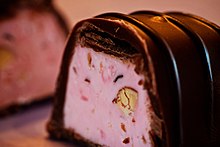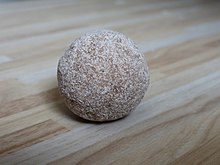Confectionery
Among the sweet products include foods that have a distinctly sweet taste. In Germany, the Federation for Food Law and Food Science e. V . (BLL) the policy for confectionery in Austria, the Austrian Food Code , the Chapter / B 16 / Sugar Candy edited.
nature
Sugar confectionery is either solid or pasty, liquid or powdery.
Filling, glaze or confectionery masses as well as layers, coatings and fillings for confectionery or fine baked goods are also among the sugar products.
With sugar-free sugar confectionery, the sweet taste is achieved through sweeteners.
Under confectionery (excluding chocolate ) refers to various, often composed of different parts sugar confectionery in a single mouthful. The term confectionery is used for high-quality sugar confectionery with reference to the ingredients that determine the value or taste (e.g. cream or nut confectionery).
If the description or presentation of sugar confectionery refers to taste and / or value-determining parts and ingredients, the confectionery must meet the requirements of the guidelines, which specify the quantities based on the weight of the finished product.
Delimitations
To the long-life baked goods
Foamed sugar products with wafer sheets, also broken, counts as sugar products, provided that the volume of the foam sugar content is greater than that of the wafer sheets and the wafer sheets do not enclose the foam sugar on all sides. Waffles are long-life baked goods .
To the cocoa products
Pralines are bite-sized products with a chocolate content of 25 percent or more based on the total weight. Bite-sized products with a chocolate content of less than 25 percent of the total weight are sugar confectionery (e.g. nut confectionery with chocolate, jelly bananas with a chocolate coating).
Products that are more than bite-sized, coated in chocolate and contain 25 percent or more of the total weight of chocolate , are “filled chocolates ”.
Products that are more than bite-sized and coated with chocolate (chocolate content less than 25 percent of the total weight) are not “filled chocolates”. Bars, marzipan bread, etc. Products can be either "filled chocolate" or "chocolate-coated sugar confectionery" depending on their chocolate content.
Products that are not completely coated (e.g. half-dipped) are not “filled chocolate” regardless of the percentage of chocolate.
In the case of products with more than 25 percent chocolate, the character of the product and the general perception of the product determine whether the product is called filled chocolate, chocolate with ... filling or praline. A chocolate-coated confectionery (e.g. chocolate toffee), in which the toffee character is predominant, can be regarded as a confectionery with a particularly thick chocolate coating.
Chocolate sprinkles and chocolate flakes are not sugar confectionery.
Beverage powders containing cocoa fall under sugar confectionery because of their high sugar content.
To the medicines
Candies such as cough, throat and throat, herb, mineral and vitamin candies and the like Products that are not medicinal products are sugar confectionery.
history
The first "sugar confectionery" that was available to humans was honey . The sugar bakery developed into its own branch when the cane sugar of the Caribbean and then the beet sugar in Europe was available in its pure form.
Ibn Jubair reported of honey and sugar confectionery in all shapes and forms that he had seen in the markets in Mecca in 1183 . According to the reports of the Rolandino of Padua , during a city festival in Treviso in 1214 a castle was built for the pleasure of the onlookers, which was stormed with projectiles made of sugar confectionery and spices .
Legal basis
There is no separate regulation for sugar confectionery. They are subject to general food law , the Food and Feed Code and numerous regulations, in particular the Food Labeling Ordinance and the Additive Approval Ordinance .
In addition, guidelines and guidelines from associations are used for assessment, which are not a legal norm, but represent a basis for the manufacture and sale of sugar confectionery for this branch of industry. They are a basis for the generally recognized quality that corresponds to consumer maintenance. The "Guideline for Sugar Products" of the Federal Food Law and Food Science e. V. as well as the guiding principles for oil seeds and the masses and confectionery made from them of the German Food Book Commission are used to assess confectionery .
List of sugar confectionery
Sweets ( hard and soft caramels )
Fondant , fondant products , and knee-leg fillings
Jelly products , gummy candies and fruit pastes
Compressed / pastilles
Marzipan , persipan and nougat products , fine marzipan
Truffles and truffle masses
White nougat and related products
Chewing gum (chewing gum and bubble gum)
Candied fruits and other candied parts of plants
Effervescent powder and brausepulver Sugar confectionery ( effervescent candy ) to eat
Powdered drink for making soft drinks
Lemonade powder and tablets for making soft drinks
Effervescent powder and tablets for making soft drinks
Glaze , filling and confectionery masses
Individual evidence
- ↑ Austrian Food Book IV. Edition Chapter / B 16 / Sugar Confectionery. Department of Women and Health, accessed July 13, 2018 .
- ↑ BLL - Guideline for Sugar Confectionery (2017). Retrieved July 13, 2018 .
- ^ Federal Association of the German Confectionery Industry. Retrieved July 13, 2018 .
- ↑ Edmund O. von Lippmann: History of sugar . Springer-Verlag, 2013, ISBN 978-3-642-50670-3 , pp. 248, 309 ( google.de [accessed on July 13, 2018]).
- ↑ Dr. Gesine Schulze Bavarian State Office for Health and Food Safety: Food: Confectionery. Retrieved July 16, 2018 .





